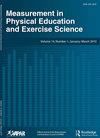Initial Validity Evidence for Responses to the Newly Developed Well-Being Actions Self-Efficacy Scale from Adults with Obesity under an Exploratory Latent Variable Approach
IF 1.9
4区 教育学
Q2 EDUCATION & EDUCATIONAL RESEARCH
Measurement in Physical Education and Exercise Science
Pub Date : 2022-09-13
DOI:10.1080/1091367X.2022.2123243
引用次数: 1
Abstract
ABSTRACT The objective of this study was to provide initial validity evidence for responses to the newly developed Well-Being Actions Self-Efficacy (WBASE) scale from adults with obesity under an exploratory latent variable approach. Longitudinal data (Nbaseline = 667 and N30 days post-baseline = 550) from the Well-Being and Physical Activity study (ClinicalTrials.gov, identifier: NCT03194854), which deployed the Fun For Wellness (FFW) intervention, were analyzed. The a priori measurement model exhibited close fit to baseline data within an exploratory framework. Similarly, there was strong evidence for at least partial temporal measurement invariance for the a priori WBASE scale measurement model. Convergent (and divergent) correlations between concordant (and discordant) pairs of well-being actions scores at baseline and latent well-being actions self-efficacy factors at 30 days post-baseline were observed. There was mixed evidence for the effectiveness of the FFW intervention to exert a direct effect on latent well-being actions self-efficacy at 30 days post-baseline.基于探索性潜变量法的肥胖成人幸福感行动自我效能量表反应的初步效度证据
摘要本研究的目的是利用探索性潜变量法,为肥胖成人对新开发的幸福行动自我效能(WBASE)量表的反应提供初步效度证据。我们分析了幸福感和身体活动研究(ClinicalTrials.gov,识别码:NCT03194854)的纵向数据(基线= 667,基线后N30天= 550),该研究采用了健康乐趣(FFW)干预。在探索性框架内,先验测量模型显示出与基线数据的密切拟合。同样,有强有力的证据表明,先验WBASE尺度测量模型至少具有部分时间测量不变性。在基线时的和谐(和不和谐)对幸福行为得分和基线后30天的潜在幸福行为自我效能因素之间观察到收敛(和发散)的相关性。对于FFW干预在基线后30天对潜在幸福行为自我效能产生直接影响的有效性,有不同的证据。
本文章由计算机程序翻译,如有差异,请以英文原文为准。
求助全文
约1分钟内获得全文
求助全文
来源期刊

Measurement in Physical Education and Exercise Science
Medicine-Orthopedics and Sports Medicine
CiteScore
4.20
自引率
33.30%
发文量
24
期刊介绍:
The scope of Measurement in Physical Education and Exercise Science (MPEES) covers original measurement research, special issues, and tutorials within six substantive disciplines of physical education and exercise science. Six of the seven sections of MPEES define the substantive disciplines within the purview of the original research to be published in the journal: Exercise Science, Physical Activity, Physical Education Pedagogy, Psychology, Research Methodology and Statistics, and Sport Management and Administration. The seventh section of MPEES, Tutorial and Teacher’s Toolbox, serves to provide an outlet for review and/or didactic manuscripts to be published in the journal. Special issues provide an avenue for a coherent set of manuscripts (e.g., four to five) to collectively focus in-depth on an important and timely measurement-related issue within the scope of MPEES. The primary aim of MPEES is to publish high-impact manuscripts, most of which will focus on original research, that fit within the scope of the journal.
 求助内容:
求助内容: 应助结果提醒方式:
应助结果提醒方式:


